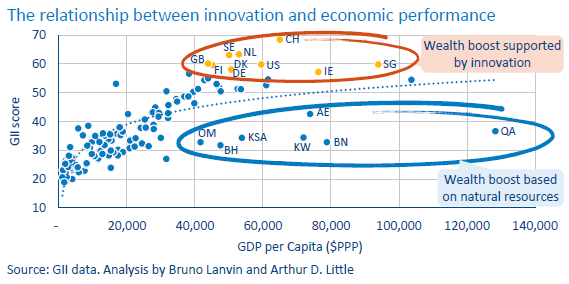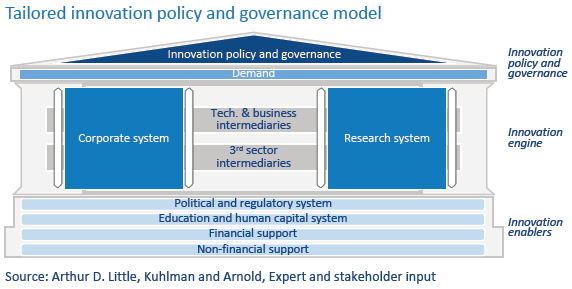
Innovation is key in driving social and economic development and bridging the wealth gap between emerging and developed countries. Over the last 50 years, only a few countries, such as South Korea and Singapore, have succeeded in unlocking the full benefits of nation-wide innovation. Instrumental to their success is a systematic approach tackling innovation in a holistic manner that captures policy, governance, innovation engines and innovation enablers to shape their innovation ecosystem and bridge systemic and market gaps. This Viewpoint provides a blueprint to policy makers to design an effective National Innovation Ecosystem and highlights successful instruments to drive ecosystem changes.
Innovation as an economic growth engine
Innovation is usually associated with the realm of inventors and researchers who create something new to the world or assemble existing technologies to create novel products and services (e.g., the ride-hailing concept in the US by companies like Uber). However, innovation is much more than that, and its largest impact comes from diffusion of knowledge, such as the adoption of a concept by local companies across the world (as Careem did in the Middle East when it launched a rival service to Uber). Innovation is, therefore, best defined following the Organization for Economic Co-operation and Development’s view of “a new or improved product or process (or combination thereof) that differs significantly from the unit’s previous products or processes and that has been made available to potential users (product) or brought into use by the unit (process).” This broader definition is more inclusive, considers areas such as social innovation and democratizes innovation, which is critical to achieve innovation’s broad social and economic benefits.
The relationship between innovation and economic development is illustrated below and shows the correlation between innovation as measured by the Global Innovation Index (GII) and nations’ wealth as measured by GDP per capita ($PPP). From the graph, countries typically derive their wealth from two sources: either by being blessed with rich natural resources or by being a leading innovator. While there are certainly additional factors in play here, one way to explain the importance of innovation for a nation’s economic wealth is that innovation allows an increase in total factor productivity by introducing new or more efficient ways to generate greater output from the same inputs, leading to economic growth.
Innovation strategy vs. industrial strategy, the chicken or egg question
If innovation is that important for economic wealth, how to achieve better results? In our work across the globe, we often see that although countries have a holistic industrial strategy in place, they are missing an overarching innovation strategy. It is important to first distinguish these two strategic domains. A country’s industrial strategy is often targeted at improving its manufacturing sector’s productivity and competitiveness through either interventionist or free market approaches, while an innovation strategy (or broader science, technology and innovation (STI) strategy) outlines the areas and means in which a country should focus its efforts to create or import innovations. The STI strategy goes beyond the manufacturing sector and includes domains such as services, government innovations and social innovation.
Industrial and innovation strategies are highly interlinked, and their exact relationship depends on the economy’s maturity. For developing economies, the innovation strategy should mainly support the achievement of the industrial strategy by targeting the technological gaps hindering industrial development. For developed economies, on the other hand, the innovation strategy should act as a guide that will shape the country’s future industrial strategy. The innovation strategy must be forward looking and ambitious, either by promoting innovations in topics that have not yet achieved mainstream status but will shape the global economy of tomorrow and allow the country a competitive head start (such as Singapore’s innovation focus on biotech) or by addressing cross-border grand challenges (such as climate change efforts or Europe’s Graphene Flagship initiative).
Countries must have a holistic innovation strategy, focusing not only on strengthening the national R&D system but also considering areas more crucial to innovation. Since the value added to a country’s economy from innovation comes mainly from diffusion and absorption of innovation rather than the process of invention (through R&D), countries must consider areas such as entrepreneurship, the labor market, firm creation, access to expertise and other factors. As such, the integrated and interlinked National Innovation Ecosystem that we describe in this Viewpoint provides the necessary framework.
Holistic National Innovation Ecosystem framework
As illustrated in the figure, the National Innovation Ecosystem employs a holistic multi-layered framework that consists of the following layers and building blocks:
- Innovation policy and governance: The first level includes national innovation policy and the governance structure to manage and promote innovation at the national level.
- The innovation engine: The second level includes the performers of innovation and institutions that link them together. This includes companies and research institutions that engage in innovation and conduct research, private and public demand for innovation efforts and intermediaries that link participants of the innovation engine.
- The innovation enablers: The third level includes enablers that support the smooth performance of the innovation engine. Such enablers include a supporting regulatory framework, an educational system that provides the required human capital to the innovation engine and financial as well as non-financial support.
As the direction-setting layer in a National Innovation Ecosystem, the innovation policy and governance model require to be tailored to the nation’s needs and specifics. The innovation policy must include a clear formulation of the country’s policy objectives and focus sectors. The number of chosen focus sectors normally correlates with the economy’s size but rarely exceeds four to six. Not surprisingly, many countries choose at least one sector in the area of technology as well as energy, water and environment. For example, Singapore defined four focus sectors in its Research Innovation Enterprise (RIE2020) plan: advanced manufacturing, urban solutions and sustainability, health and biomedical as well as services and digital economy.
While the picture is quite clear for innovation policy, no onesize-fits-all approach exists when it comes to the governance model, which needs to be tailored to fit the country’s existing ecosystem and governance logic. For example, Singapore implemented the National Research Foundation (NRF) in 2006 as a central body to set the national direction for R&D by developing policies, plans and strategies, funding strategic initiatives and building R&D capabilities.
Despite its variety, a governance model can be categorized in three archetypes: centralized, hybrid and decentralized:
- The centralized model is adopted by rapidly growing innovation countries such as Turkey, China, Singapore, Malaysia and the United Arab Emirates (UAE). It utilizes centralized policy and implementation planning but allocates implementation to individual execution bodies.
- The hybrid model is used by established innovation countries such as Finland, Norway and Korea. It assigns the responsibility to define the policy focus to a central body while leaving the executive bodies independent when defining implementation measures.
- The decentralized model gives the executive bodies complete autonomy to define policies and implementation measures.
In addition to the policy and governance model, an additional lever exists to direct the ecosystem’s innovation engine: demand. This includes private and public demand for goods and services. Government demand can be a key driver for innovation in countries with a high share of public spending, such as in the Middle East. Governments can use demand to support and steer innovation through public procurement quotas or advanced procurement, among other methods. One example for demanddriving instruments is Korea’s New Technology Purchasing Assurance Program, which requires at least 10 percent of total procurement contracts be awarded to small and mid-size enterprises (SMEs) and 20 percent to products categorized as “new excellent products.” Another example can be found with the US public institutions that often procure non-commercially ready products to support their commercialization. Such an approach is used to support the private space launcher business in the US, for example.
Well-oiled innovation engine
As shown in the figure, a well-oiled innovation engine consists of three components: corporate system, research system and intermediaries. In order to create economic value through innovation, a productive corporate system – consisting of multinationals, SMEs as well as startups – is required to develop and commercialize knowledge. Following Nobel Laureate Kenneth Arrow’s arguments from 1962, the economic value created by a corporate system is highest if a healthy amount of competition exists between the system’s firms, since that will force them to continuously innovate to gain a competitive edge through diffusion of new innovation and new practices. Besides promoting competition between existing market participants (e.g., through regulation as discussed below under innovation enablers), competition will also increase thanks to new market participants or startups.
Both the knowledge that helps create new startups, as well as the knowledge that is exploited by existing companies to innovate (if not developed within the corporate system), comes from the research system, consisting of universities and research institutes. Therefore, to create a well-oiled innovation engine, it is critical to assure relevance of research output and optimal alignment between the corporate and the research systems. A multitude of instruments are available to improve the flow of knowledge between both systems and increase commercialization rate. One such instrument is the creation of intermediaries such as innovation centers, incubators, technology-transfer offices or entrepreneurial networks. One success story can be found at the Massachusetts Institute of Technology (MIT) innovation center, which boasts more than 30,000 currently active companies founded by MIT alumni, with a total of 4.6 million employees and US $1.9 trillion in annual revenue. To encourage entrepreneurship and innovation, MIT’s innovation center offers mentoring, training, office space, network access, funding (seed funding up to US $25,000) and functional support (e.g., marketing, prototyping and finance support services).
Unfortunately, it is not enough to just create the three components of the innovation engine (corporate system, research system and intermediaries). They also need to be enabled for them to perform their role in the National Innovation Ecosystem.
Supportive innovation enablers
To support the National Innovation Ecosystem, a set of four enablers is needed. These enablers include: the political and regulatory system, the education and human capital system, financial support and non-financial support.
Leading innovative countries use their political and regulatory systems to enable both their corporate systems and research systems. Regulations need to mainly focus on four areas: taxes, competition, ease of doing business and rule of law. Taxes can be used to incentivize innovation (e.g., tax breaks for development cost). Competition is improved by establishing and enforcing antitrust laws that prevent monopolistic behavior. Ease of doing business is increased by different regulatory instruments and should largely focus on startup creation in the context of supporting innovation (e.g., reducing minimum capital requirements and simplifying documentation requirements for starting a business and increasing ease of solving insolvency). This needs constant attention by lawmakers since this is an area where countries are in continuous competition to attract companies. For example, the UAE is often chosen as the Middle East headquarters for foreign businesses in part due to its attractive regulatory environment compared to other Middle Eastern countries. Rule of law is particularly important for less developed economies to increase confidence of investors and includes regulatory aspects such as protection of property rights and enforcing minority investor protection. Of course, in addition to these four main areas (taxes, competition, ease of doing business and rule of law), further relevant regulatory aspects exist to support innovation, such as removing regulatory restrictions on researchers to participate in commercialization efforts.
The second innovation enabler is the education and human capital system, which ensures a constant supply of highcaliber talent to the job market. The education system must be aligned with the labor market requirements and needs to focus on creativity and entrepreneurship. For example, Finland encourages entrepreneurship programs in universities and colleges through its Business Protomo concept (open business development platforms where students and industry can meet to form potential ventures). This enabler also creates an attractive environment for foreign talent. One example are the established programs by the US government, including its temporary employer-sponsored work visa system and dedicated categories of permanent residence granted to persons with extraordinary ability and outstanding professors and researchers.
The final innovation enablers include financial support and nonfinancial support. Besides assuring the availability of a working financial system that includes the availability of high-risk funding (e.g., incentives for venture capital funds), policy makers can provide state financial support to drive innovation. The latter includes, for example, providing guarantees to companies trying to obtain bank loans and directly funding companies with highrisk loans. For instance, Norway directly finances SMEs through equity (e.g., Investinor) and loans managed by Innovation Norway.
In terms of non-financial support, the most notable instruments at the disposal of policy makers include the creation of innovation clusters and economic zones. For example, Singapore has created nine free-trade zones. Each economic zone has clear objectives (e.g., in terms of focus sectors), implemented tailored policies to attract investors (e.g., tax advantages) and allocated key locations to target companies.
Key insights for decision makers
The picture is clear: there is no economic growth without innovation. Fortunately, a nation can improve its innovation performance by applying a comprehensive, multi-layered framework with a focus on the interlinkages between the various blocks of this framework. To ensure the innovation policy is effective, policy makers must ask themselves these critical questions:
- Is our innovation policy clearly defined and does it provide direction to the other layers of the National Innovation Ecosystem?
- Is our innovation governance model appropriate to the local context and the objectives that should be achieved?
- Does our innovation engine have all required components (corporate system, research system and intermediaries) and are they adequately interlinked?
- Does our innovation engine have all innovation enablers in place?









